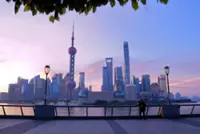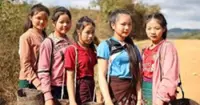The Luoxiagou Village at Dong Chuan Redland. — Photos: KATHERINE KUAN
Right before my eyes were miles and miles of colourful rice terraces. It was truly a sight to behold.
I was in Yuan Yang, a town in Yunnan, China with my husband in late October. From our third floor hotel window, in the wee hours of the morning I saw the sun peeping out from the mountains and lighting up the Duo-yishu Rice Terraces. The colours slowly changed from white to different hues: yellow, blue, grey and gold. I was awestruck by the magical moment.
Our tour of 16 senior travellers – aged between 63 and 85 – together with our tour leader, Rhys, flew from Kuala Lumpur to Kunming, the capital of Yunnan. We stayed in Kunming for three nights, then travelled by bus to different places nearby, namely Cheng Jiang, Jian Shui, Yuan Yang and Mi Le. We had an English-speaking local tour guide named Tony Huang, who regaled us with stories at every site.
Yuan Yang is famous for its scenic rice terraces, carved into the hills and mountains by the Hani minority people who have lived in the area for centuries. The terraces’ history spans around 1,200 years.
In 2013, 16,603ha of the Honghe Hani Rice Terraces were listed as a Unesco World Heritage Site, because of their outstanding resilient construction and unique social-ecological system, as well as the culture of the Hani people.
We were also bowled over by what sunset looked like at the Bada Rice Terraces. The colour changes on the rice fields were astounding. Although I could not see all colours of the rainbow, I managed to capture the rice fields in white, beige, orange, green and even black.
Generally, rice starts to grow in May there. By June, they are green, then yellow from July to September. Harvesting is in October and by November the fields are cleaned and filled with water. The myriad of colours we saw were due to the reflection of light on the rice fields.
Huang explained: “The colour changes depend on many factors – sunrise or sunset, time of the day and the atmosphere, whether it is a clear, cloudy or misty day. Different seasons also bring different colours.”
On another day, I was captivated by the Dongchuan Redland, a three-hour drive from Kunming. This place is more than 20sq km of red, terraced hills. We visited Huashitou and Luoxiagou villages and were greeted by terraces in multi-colours such as red, orange, green, beige and brown.
Dubbed “God’s Palette”, the Dongchuan Redland looked like an oil-painting.
“The soil is red. When some fields are grown with potato, barley or wheat, the colour of their flowers, leaves and stems plus the blue sky produce the different colours that we see,” shared Huang.
Our visits included two ethnic minority villages. The Azhike village of the ethnic Hani people in Yuan Yang is more than 210 years old, and those who live there are mostly farmers, tilling the land and rearing poultry. Their three-storey houses had mushroom-shaped roofs made from hay.
The Chengzi Village of ethnic Yi folks in Mi Le, meanwhile, is more than 300 years old. The roofs there were flat with many layers of straw and clay. The flat roofs were built to facilitate the drying of produce, mainly corn.
We all liked the ethnic markets, which were like a festival of colours, where visitors mingled with the ethnic minority in their traditional costumes.
The best was Shengcun Market where I got lost ... but only temporarily, thankfully! The variety of merchandise on sale was fascinating: fruits, vegetables, meat, clothes, embroidery, haberdashery, household items, souvenirs and food, as well as a buffalo head, maggots and insects.
There were even a cutler and a dentist who offered their services in the middle of the market!
We visited other places of historical and cultural significance, like the Xing Meng Mongol Ethnic Town, where Mongolian people lived and still donned their traditional costumes daily.
We went to the Double Dragon Bridge, built in the Qing Dynasty under Emperor Qian Long. This bridge is hailed as a masterpiece of traditional Chinese bridge-building.
We saw the Confucius Temple, too. Originally constructed in 1285 and renovated 40 times, the temple operated as a school for nearly 750 years for local students and students from other provinces.
Meanwhile, DaBanJing is where you’ll find a 600-year-old well that supplies clean water to residents; there’s a tofu factory nearby you can check out too.
Yunnan has much to offer, like vibrant cities, picturesque scenes and rich cultures. I definitely came home with sweet memories of a wonderful holiday.
The views expressed are entirely the reader’s own.








